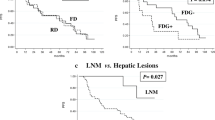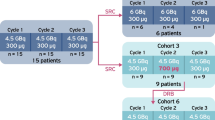Abstract
Background
Lutetium (Lu)-177 peptide receptor radionuclide therapy (PRRT) is one of the standard treatments for somatostatin receptor-positive well-differentiated neuroendocrine tumors (NETs). However, limited Asian representation in the pivotal NETTER-1 trial and a lack of real-world data for Lu-177 PRRT from Asian regions exist.
Objective
This retrospective study aimed to evaluate the efficacy and safety of Lu-177 PRRT in Korean patients with advanced NETs.
Patients and Methods
This study analyzed 64 patients treated with Lu-177 DOTATATE PRRT at the Asan Medical Center, Seoul, Korea, between November 2019 and December 2022. The primary endpoint was progression-free survival (PFS), and the secondary endpoints included overall survival (OS), objective response rate (ORR), and safety profile.
Results
The median age of patients was 55 years. Prior to PRRT, patients received a median of two lines (range 0–6) of systemic therapy. Fifty (78%) patients received the planned four cycles of Lu-177 DOTATATE PRRT. The median PFS was 21.7 months (95% confidence interval 16.7–not available) and the ORR was 20%. With a median follow-up of 15.7 months (range 1.0–39.3), the median OS was not reached and the 1-year OS rate was 88%. The median PFS was better in patients with grade 1–2 NETs than in those with grade 3 NET (not reached vs. 14.2 months; hazard ratio 3.15; p = 0.0058). Hematological toxicities were the common adverse events, including grade ≥ 3 anemia (7.8%), neutropenia (10.9%), and thrombocytopenia (9.4%).
Conclusions
In Korean patients with advanced NETs, Lu-177 DOTATATE PRRT showed efficacy and safety outcomes, consistent with those in the NETTER-1 trial and previous Western real-world studies.



Similar content being viewed by others
References
Dasari A, Shen C, Halperin D, Zhao B, Zhou S, Xu Y, et al. Trends in the incidence, prevalence, and survival outcomes in patients with neuroendocrine tumors in the United States. JAMA Oncol. 2017;3:1335–42.
Li G, Tian ML, Bing YT, Tao LY, Wang HY, Jiang B, et al. Clinicopathological features and prognosis factors for survival in elderly patients with pancreatic neuroendocrine tumor: a STROBE-compliant article. Medicine (Baltimore). 2019;98: e14576.
Frilling A, Modlin IM, Kidd M, Russell C, Breitenstein S, Salem R, et al. Recommendations for management of patients with neuroendocrine liver metastases. Lancet Oncol. 2014;15:e8-21.
Yao JC, Shah MH, Ito T, Bohas CL, Wolin EM, Van Cutsem E, et al. Everolimus for advanced pancreatic neuroendocrine tumors. N Engl J Med. 2011;364:514–23.
Pavel M, Oberg K, Falconi M, Krenning EP, Sundin A, Perren A, et al. Gastroenteropancreatic neuroendocrine neoplasms: ESMO clinical practice guidelines for diagnosis, treatment and follow-up. Ann Oncol. 2020;31:844–60.
Raymond E, Dahan L, Raoul JL, Bang YJ, Borbath I, Lombard-Bohas C, et al. Sunitinib malate for the treatment of pancreatic neuroendocrine tumors. N Engl J Med. 2011;364:501–13.
Jeong H, Shin J, Jeong JH, Kim KP, Hong SM, Kim YI, et al. Capecitabine plus temozolomide in patients with grade 3 unresectable or metastatic gastroenteropancreatic neuroendocrine neoplasms with Ki-67 index < 55%: single-arm phase II study. ESMO Open. 2021;6: 100119.
Kang J, Yoo C, Hwang HS, Hong SM, Kim KP, Kim SY, et al. Efficacy and safety of lanreotide in Korean patients with metastatic, well-differentiated gastroenteropancreatic-neuroendocrine tumors: a retrospective analysis. Invest New Drugs. 2019;37:763–70.
Yoo C, Cho H, Song MJ, Hong SM, Kim KP, Chang HM, et al. Efficacy and safety of everolimus and sunitinib in patients with gastroenteropancreatic neuroendocrine tumor. Cancer Chemother Pharmacol. 2017;79:139–46.
Yoo C, Oh CR, Kim ST, Bae WK, Choi HJ, Oh DY, et al. Systemic treatment of advanced gastroenteropancreatic neuroendocrine tumors in Korea: literature review and expert opinion. Cancer Res Treat. 2021;53:291–300.
Kwekkeboom DJ, Teunissen JJ, Bakker WH, Kooij PP, de Herder WW, Feelders RA, et al. Radiolabeled somatostatin analog [177Lu-DOTA0, Tyr3]octreotate in patients with endocrine gastroenteropancreatic tumors. J Clin Oncol. 2005;23:2754–62.
Kwekkeboom DJ, de Herder WW, Kam BL, van Eijck CH, van Essen M, Kooij PP, et al. Treatment with the radiolabeled somatostatin analog [177 Lu-DOTA 0, Tyr3]octreotate: toxicity, efficacy, and survival. J Clin Oncol. 2008;26:2124–30.
Strosberg J, El-Haddad G, Wolin E, Hendifar A, Yao J, Chasen B, et al. Phase 3 trial of (177)Lu-DOTATATE for midgut neuroendocrine tumors. N Engl J Med. 2017;376:125–35.
Hope TA, Abbott A, Colucci K, Bushnell DL, Gardner L, Graham WS, et al. NANETS/SNMMI procedure standard for somatostatin receptor-based peptide receptor radionuclide therapy with (177)Lu-DOTATATE. J Nucl Med. 2019;60:937–43.
Eisenhauer EA, Therasse P, Bogaerts J, Schwartz LH, Sargent D, Ford R, et al. New response evaluation criteria in solid tumours: revised RECIST guideline (version 1.1). Eur J Cancer. 2009;45:228–47.
Klimstra DS KG, La Rosa S, Rindi G, editors. Classification of neuroendocrine neoplasms of the digestive system. In: WHO classification of tumours: digestive system tumours, 5th edn. Lyon: International Agency for Research on Cancer; 2019.
Kong G, Callahan J, Hofman MS, Pattison DA, Akhurst T, Michael M, et al. High clinical and morphologic response using (90)Y-DOTA-octreotate sequenced with (177)Lu-DOTA-octreotate induction peptide receptor chemoradionuclide therapy (PRCRT) for bulky neuroendocrine tumours. Eur J Nucl Med Mol Imaging. 2017;44:476–89.
Brabander T, van der Zwan WA, Teunissen JJM, Kam BLR, Feelders RA, de Herder WW, et al. Long-term efficacy, survival, and safety of [(177)Lu-DOTA(0), Tyr(3)]octreotate in patients with gastroenteropancreatic and bronchial neuroendocrine tumors. Clin Cancer Res. 2017;23:4617–24.
Bodei L, Cremonesi M, Grana CM, Fazio N, Iodice S, Baio SM, et al. Peptide receptor radionuclide therapy with (1)(7)(7)Lu-DOTATATE: the IEO phase I–II study. Eur J Nucl Med Mol Imaging. 2011;38:2125–35.
Sabet A, Dautzenberg K, Haslerud T, Aouf A, Sabet A, Simon B, et al. Specific efficacy of peptide receptor radionuclide therapy with (177)Lu-octreotate in advanced neuroendocrine tumours of the small intestine. Eur J Nucl Med Mol Imaging. 2015;42:1238–46.
Sansovini M, Severi S, Ambrosetti A, Monti M, Nanni O, Sarnelli A, et al. Treatment with the radiolabelled somatostatin analog Lu-DOTATATE for advanced pancreatic neuroendocrine tumors. Neuroendocrinology. 2013;97:347–54.
Strosberg JR, Caplin ME, Kunz PL, Ruszniewski PB, Bodei L, Hendifar A, et al. (177)Lu-Dotatate plus long-acting octreotide versus high-dose long-acting octreotide in patients with midgut neuroendocrine tumours (NETTER-1): final overall survival and long-term safety results from an open-label, randomised, controlled, phase 3 trial. Lancet Oncol. 2021;22:1752–63.
Clement D, Navalkissoor S, Srirajaskanthan R, Courbon F, Dierickx L, Eccles A, et al. Efficacy and safety of (177)Lu-DOTATATE in patients with advanced pancreatic neuroendocrine tumours: data from the NETTER-R international, retrospective study. Eur J Nucl Med Mol Imaging. 2022;49:3529–37.
Ezziddin S, Opitz M, Attassi M, Biermann K, Sabet A, Guhlke S, et al. Impact of the Ki-67 proliferation index on response to peptide receptor radionuclide therapy. Eur J Nucl Med Mol Imaging. 2011;38:459–66.
Thang SP, Lung MS, Kong G, Hofman MS, Callahan J, Michael M, et al. Peptide receptor radionuclide therapy (PRRT) in European Neuroendocrine Tumour Society (ENETS) grade 3 (G3) neuroendocrine neoplasia (NEN): a single-institution retrospective analysis. Eur J Nucl Med Mol Imaging. 2018;45:262–77.
Zhang J, Kulkarni HR, Singh A, Niepsch K, Muller D, Baum RP. Peptide receptor radionuclide therapy in grade 3 neuroendocrine neoplasms: safety and survival analysis in 69 patients. J Nucl Med. 2019;60:377–85.
Ezziddin S, Attassi M, Yong-Hing CJ, Ahmadzadehfar H, Willinek W, Grunwald F, et al. Predictors of long-term outcome in patients with well-differentiated gastroenteropancreatic neuroendocrine tumors after peptide receptor radionuclide therapy with 177Lu-octreotate. J Nucl Med. 2014;55:183–90.
Author information
Authors and Affiliations
Corresponding authors
Ethics declarations
Funding
This study was supported in part by the Asan Institute for Life Sciences, Asan Medical Center, Seoul, Korea [grant numbers 2021IF0022]. The funder had no role in the design, analysis, or interpretation of the study.
Conflict of interest
Yeokyeong Shin, Bo Hyun Moon, Baek-Yeol Ryoo, Heung-Moon Chang, Kyu-pyo Kim, Yong Sang Hong, Tae Won Kim, Jin-Sook Ryu, Yong-il Kim, and Changhoon Yoo declare that they have no conflicts of interest that might be relevant to the contents of this manuscript.
Availability of data and material
All data supporting the findings of this study are available within the paper and its electronic supplementary material.
Ethics approval
This retrospective study was conducted in accordance with the Declaration of Helsinki and the International Conference on Harmonization Guidelines for Good Clinical Practice. The protocol was approved by the Institutional Review Board of Asan Medical Center (#2022-1065).
Consent to participate
Informed consent from all patients was waived.
Consent for publication
As this article did not contain any identifiable patient data, additional informed consent from the patients was waived.
Code availability
Not applicable.
Author contributions
CY contributed to the study conception and design. Material preparation and data collection were performed by YS, BHM, B-YR, H-MC, K-PK, YSH, TWK, J-SR, Y-IK and CY. Data analysis was performed by YS, Y-IK and CY. The first draft of the manuscript was written by YS, Y-IK, and CY, and all authors commented on previous versions of the manuscript. All authors read and approved the final manuscript.
Supplementary Information
Below is the link to the electronic supplementary material.
Rights and permissions
Springer Nature or its licensor (e.g. a society or other partner) holds exclusive rights to this article under a publishing agreement with the author(s) or other rightsholder(s); author self-archiving of the accepted manuscript version of this article is solely governed by the terms of such publishing agreement and applicable law.
About this article
Cite this article
Shin, Y., Moon, B.H., Ryoo, BY. et al. Efficacy and Safety of Lu-177 DOTATATE Peptide Receptor Radionuclide Therapy in Patients with Unresectable or Metastatic Neuroendocrine Tumors in Korea. Targ Oncol 19, 41–49 (2024). https://doi.org/10.1007/s11523-023-01022-z
Accepted:
Published:
Issue Date:
DOI: https://doi.org/10.1007/s11523-023-01022-z




